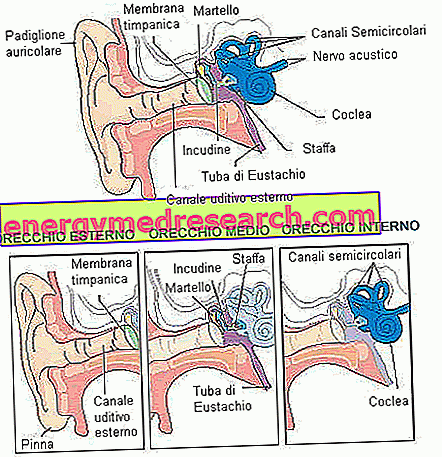Key points
Otitis media is an acute or chronic inflammation of the middle ear.
Causes
Otitis media is a common complication of colds, pharyngitis, flu and allergies. Other predisposing factors include: shingles, enlargement of the adenoids, scarlet fever.
Symptoms
Otitis media is accompanied by inflammation and pain in the ears (otalgia), accompanied by the characteristic symptoms of the triggering disease: sore throat, fever / low-grade fever, nasal congestion (stuffy nose), cough.
Therapy
Therapy for the treatment of otitis media depends on the triggering cause: antibiotics (for bacterial otitis), antivirals (for virus infections), therapeutic aids (for pain control).

Otitis media
The term "otitis media" defines an infectious-inflammatory process affecting the middle ear, the cavity comprising tympanum and three small ossicles (stirrup, anvil and hammer). Otitis media is generally caused by bacterial or viral infections; less frequently, inflammation of the middle ear is the result of allergic reactions or ear cancer.
Although it is a rather annoying disease, uncomplicated otitis media tends to heal spontaneously within 10-15 days.
Causes
Otitis media represents a frequent complication of colds, pharyngitis, flu and allergies: by occluding the Eustachian tube, these diseases favor the accumulation of secretions in the middle ear, thus constituting an ideal fertile ground for the proliferation of pathogens from the throat.
To understand...
The space behind the eardrum is connected to the back of the throat (rhinopharynx) through a small duct, called the Eustachian tube. Under physiological conditions, this cavity is filled with air; in case of cold or flu, the Eustachian tube is filled with mucus, often rich in pathogens.
- Influenza diseases → accumulation of infected mucus in the Eustachian tube → local swelling and inflammation → otitis media
The Eustachian tube can also be occluded by the enlargement of the adenoids, lymphatic stations that play an important immune function. Adenoid inflammation makes the patient more vulnerable to infection, including otitis.
Although unlikely, bacteria and viruses can reach the auricular level through the blood: in similar situations, scarlet fever (caused by group A beta-hemolytic streptococcus) is the most important risk factor.
Otitis media can also be triggered by a bacterial / viral proliferation after a tympanic perforation.
Even the shingles fire can cause otitis media: in similar situations, the inflammation of the middle ear takes on the most precise connotation of Herpes zoster oticus .
Sometimes, it is not possible to trace any precise cause: in this case, one speaks of idiopathic otitis media.
Incidence
It is estimated that, after infections in the upper airways, acute otitis media is the most common childhood disease: the preferred target of the disease is preschool children. After 7-8 years, infections of the middle ear are less frequent, as the child's immune defenses become more efficient. Despite what has been said, otitis media can occur in all ages, so it can also affect adults and the elderly.
Approximately, every year 16 million children are affected by otitis media: in a third of these, the disease tends to recur 6 times or more until the age of 7.
In industrialized countries, the mortality rate for otitis media is extremely low (<1 child per 100, 000 affected by otitis media). In developing countries, on the other hand, otitis media is still an extremely recurrent phenomenon, and remains one of the main causes of infant mortality.
In general, otitis media is a progressively increasing pathological condition: probably this is due to environmental pollution.
But why does otitis media manifest itself more often in young children?
Otitis media is an almost exclusive phenomenon for preschool children because:
- The immune defenses of young children are still not completely efficient
- The Eustachian tube of small children has particular characteristics, such as to expose them more easily to the risk of infections: the canaliculus is in fact narrower and shorter than that of older children and adults
Symptoms and complications
SYMPTOMS
Being caused by bacterial / viral infections, otitis media is often accompanied by the discharge of purulent material from the external auditory canal, responsible for pain, itching and local inflammation (acute purulent otitis media). In addition to these symptoms, the clinical picture of otitis media is completed by the characteristic prodromes of the triggering disease, such as headache, nasal congestion, diarrhea, fever / low-grade fever, sore throat, cough and vomiting.
In the child suffering from otitis media, other secondary symptoms are often observed: alteration of mood, loss of appetite, irritability, otalgia, otorrhea, continuous crying.
In some cases, otitis media can cause your child more serious problems, such as loss of balance, ringing in the ears (tinnitus) and sleep disorders.
COMPLICATIONS
In complicated otitis media, the clinical picture of the affected patient can degenerate:
- Severe hearing impairment, often due to permanent damage to the eardrum
- Developmental delay: although rare, this complication may result from temporary or definitive hearing impairment in neonatal age
- Spread of infection in neighboring sites: otitis media can spread to involve surrounding cells and tissues. In fact, mastoiditis is a possible complication of otitis media.
Diagnosis
The visit with the otoscope is one of the most widely used diagnostic tests to confirm a suspicion of otitis media. With this instrument, the doctor, by blowing air into the patient's ear, is able to assess the appearance and possible degree of impairment of the eardrum: in the case of otitis media, in fact, the tympanic membrane appears red and swollen.
When the diagnosis is doubtful, the doctor may subject the patient to other diagnostic tests:
- Timpanogramma: is an investigative test useful for assessing the presence of fluid / mucus in the middle ear and the functionality of the Eustachian tube
- Tympanometry: the test evaluates the movement of the eardrum and the pressure inside the middle ear
- Audiometric examination: assesses the possible hearing loss / reduction
- CT: sometimes, this imaging test is necessary to evaluate a possible involvement of structures close to the middle ear
Care
Although acute otitis media tends to resolve spontaneously over a few days, in some cases it is necessary to intervene pharmacologically. In fact, in particularly sensitive, immunocompromised or debilitated patients, the clinical picture of otitis media can collapse until the eardrum is perforated.
Considering that in most cases otitis media depends on bacterial infections, antibiotics are the most suitable drugs for this purpose. In the case of viral otitis, on the other hand, it is recommended to take antiviral drugs, clearly after medical supervision.
Antibiotic / antiviral therapy may be associated with a pain-relieving drug, useful for relieving ear pain and speeding up complete recovery times. Still, applying warm compresses to the ear can temporarily relieve the pain caused by otitis media.
Different discourse must be placed for the suppurative variant: in similar situations, antibiotic / antiviral therapy for otitis treatment is associated with an intervention aimed at draining the fluid accumulated inside the middle ear.



